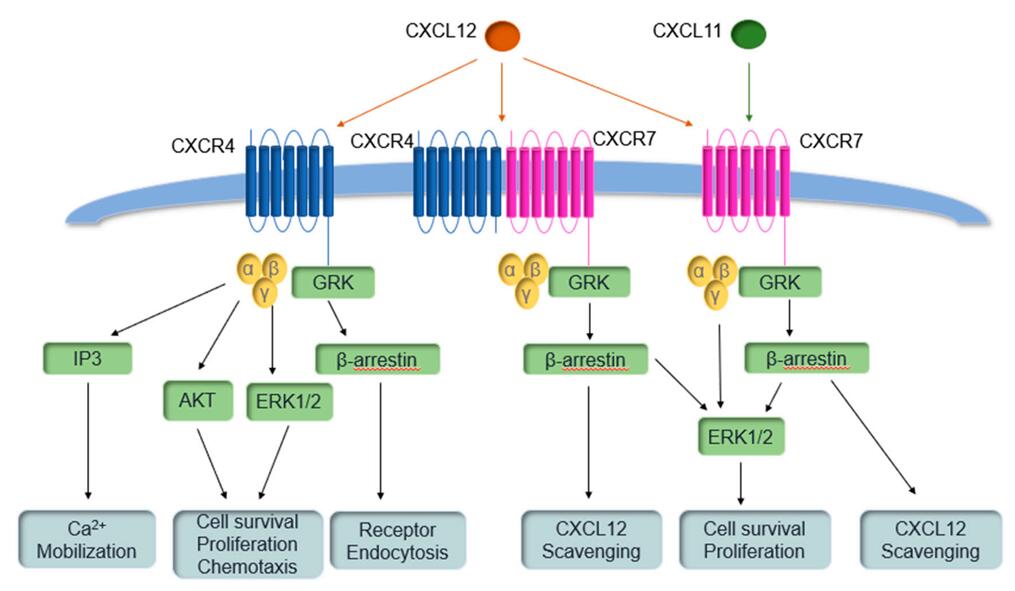
Our promise to you:
Guaranteed product quality, expert customer support.
 24x7 CUSTOMER SERVICE
24x7 CUSTOMER SERVICE
 CONTACT US TO ORDER
CONTACT US TO ORDER
CXCR7 Gene Editing 
Chemokines and their receptors play a key role in many physiological and pathological processes, including cancer, and exert their effects through a variety of mechanisms. Chemokine CXCL12 (stromal cell-derived factor 1α, SDF-1α) and its receptor, chemokine (C-X-C motif) receptor 4 (CXCR4), contribute to the growth of primary tumors, and the progress of metastatic diseases. CXC chemokine receptor 7 (CXCR7) is a newly found receptor for CXCL12, which is an atypical, chemokine-specific seven-transmembrane G protein-coupled receptor that does not mediate typical chemokine responses, such as regulating intracellular calcium mobilization or adenylyl cyclase activity. Studies have shown that the binding affinity of CXCL12 to CXCR7 is tenfold higher than to CXCR4. Similar to CXCR4, CXCR7 can also be used as a crucial regulator in several physiologic processes. CXCR7 plays an important role in embryonic development and participates in weakening chemotaxis of T lymphocytes induced by CXCL12. It is also involved in trafficking of germ and progenitor cells during tissue repair and development.
 Figure 1. CXC chemokine receptor 4 (CXCR4) and CXCR7 pathways. (Lounsbury N., 2020)
Figure 1. CXC chemokine receptor 4 (CXCR4) and CXCR7 pathways. (Lounsbury N., 2020)
The Physiological Roles of CXCR7
Targeted deletion of SDF-1/CXCL12 and CXCR4 results in similar phenotypes including abnormalities in the development of the hematopoietic system, cardiovascular system, and numerous brain structures. Therefore, SDF-1/CXCL12 and CXCR4 for long have been considered as a nonredundant chemokine/receptor system. Like CXCR4, CXCR7 serves as a co-receptor for some HIV-1 strains and has also been proven to participate in tumor growth. Characterization of CXCR7-deficient mice revealed the role of CXCR7 in cardiac development, fetal endothelial biology, and B-cell localization. Besides, CXCR7 has been shown to be essential in the migratory properties of mouse cortical neurons. In addition to SDF-1/CXCL12, CXCR7 binds to the CXCL11 chemokine, but has a lower affinity. Although its ligand binding properties, CXCR7 does not seem to signal like a conventional receptor and fails to couple to classic G-protein signaling pathways activated by chemokines. In fact, it has been suggested that CXCR7 may not always function alone but may also regulate the function of CXCR4. Emerging evidence shows that CXCR7 is widely expressed in various tumor tissues and has the function of activating endothelial cells, promoting the proliferation, migration, invasion, and metastasis of cancer cells. In bladder cancer, high expression of CXCR7 is related to the proliferation, migration, and invasion of cancer cells, leading to rapid tumor progress. In addition, high expression of CXCR7 has indicated more lymphovascular invasion, regional lymph node metastasis and severe invasion in extramammary Paget disease.
CXCR7 As a Therapeutic Target
The discovery of CXCR7 has provided a viable target for anti-tumor and anti-metastatic drugs for human beings. Using the model of mice engrafted with lung and breast cancer cell lines, inhibiting CXCR7 with believed antagonists showed that CXCR7 is able to promote tumor growth. On the other hand, research shows that both CXCR4 and CXCR7 responded to CXCL12 to greatly increase human lymphoma cells' migration, suggesting that CXCR7 might be an efficient target for cancer treatment. Because the expression of CXCR7 may be able to direct hematopoietic stem cells (HSCs) to the niches which sustain their migration capacity, CXCR7 is a potential regulatory target for HSCs mobilization-inducing agent development. This is supported by an in vitro study, which shows that although CXCR7 is not an intrinsic signaling receptor for CXCL12 on CD34+ HSCs, its blocking can be useful for therapeutic interference with CXCR4-mediated activation of integrins and cell adhesion. Moreover, a recent in vivo study provided further evidence that CXCR7 contributes to homing of acute myeloid leukemia and normal CD34+ progenitor cells to the bone marrow and spleen of NOD/SCID mice. However, the further mechanistic study is needed to fully understand the role of CXCR7 in HSCs. Although the ability of CXCR7 to regulate the BMSC niche is still in debate, the study of CXCR7 antagonists is a hot spot among HSCs mobilizers, because this may provide an alternative treatment for patients when other mobilization protocols fail.
CXCR7 Gene Editing Services
CRISPR/Cas9 PlatformCB at Creative Biogene is dedicated to offering comprehensive CRISPR/Cas9 gene editing services and products for academic research, biotech research and pharmaceutical drug discovery. With deep gene editing knowledge and extensive experience in experimental operation and data processing, we help you effectively control CXCR7 genes knockout/knockin/point mutation in cells or animals via CRISPR/Cas9 technology.
| Service | Details | Alternative cell lines or animal species |
| CXCR7 Gene Editing Cell Line Generation | gRNA design and synthesis Transfect the cell lines you're interested Select the high expression cells and sort monoclonal cell Validate the knockout/knockin/point mutation of CXCR7 by PCR and sequencing Provide cryogenically preserved vials of stable cells and final reports | HEK239T, Hela, HepG2, U87, Ba/F3, CHO, MDA-MB-453, MDA-MB-231NIH3T3, T47D, Neuro2a, MCF7, RKO, K562, RAW264.7, etc. |
| CXCR7 Gene Editing Animal Model Generation | CXCR7 gene conventional knockout animals CXCR7 gene conditional knockout animals CXCR7 point mutation animals CXCR7 knockin animals | Mouse, rat, rabbit, zebrafish, C. elegans, etc. |
Related Products at CRISPR/Cas9 PlatformCB
References
- Banisadr G, et al. Pattern of CXCR7 gene expression in mouse brain under normal and inflammatory conditions. Journal of Neuroimmune Pharmacology, 2016, 11(1): 26-35.
- Wang C, et al. CXCR7 targeting and its major disease relevance. Frontiers in pharmacology, 2018, 9: 641.
- Liu Y, et al. Targeting chemokine receptor CXCR7 inhibits glioma cell proliferation and mobility. Anticancer research, 2015, 35(1): 53-64.
- Fan H, et al. Prognostic significance of CXCR7 in cancer patients: a meta-analysis. Cancer cell international, 2018, 18(1): 1-16.
- Lounsbury N. Advances in CXCR7 modulators. Pharmaceuticals, 2020, 13(2): 33.